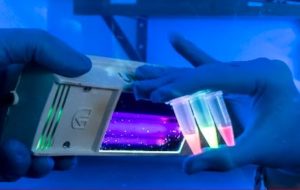With a shortage of coronavirus testing kits in many places around the globe, scientists have stepped up to produce a plethora of kit scenarios, each more creative than the next. Now, investigators at Simon Fraser University (SFU) are throwing their hat into the coronavirus diagnostic wing with the use of their pioneering imaging technology—called Mango, for its vivid color.
The researchers originally developed Mango to sensitively detect RNA molecules, helping to improve viral screening for viruses such as the coronavirus while enabling fundamental discoveries into the functioning of cells. The findings from this study were published recently in Nature Communications through an article titled “Live-cell imaging of single RNA molecules with fluorogenic Mango II arrays.”
“We are made of molecules so when something goes wrong within a cell, it happens at the molecular level,” explained senior study investigator Peter Unrau, PhD, a professor of molecular biology and biochemistry at SFU. “We are using the Mango system as a catalyst, to allow us to not only extend fundamental research questions but also to detect pathogens like the coronavirus, faster and more efficiently.”
The Mango system consists of an RNA Mango aptamer that binds tightly and specifically to a fluorescent dye. The aptamer acts like a magnet—targeting and binding those dye molecules. The dye becomes excitable when bound and glows brightly. RNA molecules modified to contain the aptamer “magnet” now stand out from the other parts of the cell, which makes it much easier for researchers to see and study RNA molecules under a microscope.
“RNA aptamers, such as Spinach and Mango, have recently emerged as a powerful background-free technology for live-cell RNA imaging due to their fluorogenic properties upon ligand binding, the authors wrote. “We found a novel array of Mango II aptamers for RNA imaging in live and fixed cells with high contrast and single-molecule sensitivity. Direct comparison of Mango II and MS2-tdMCP-mCherry dual-labeled mRNAs show marked improvements in signal-to-noise ratio using the fluorogenic Mango aptamers.”

“Cell regulation takes place at the level of RNA,” Unrau added. “For a long time, the focus has been on protein, but it is RNA and not protein that regulates the vast majority of processes within a cell.”
RNA Mango dyes are currently available from Applied Biological Materials (ABM) in Richmond, B.C. The coronavirus research made possible by the Canadian Institutes of Health Research funding will allow the team to develop an isothermal testing methodology, known as Mango NABSA (nucleic acid sequence-based amplification).
The Mango NABSA kits can be used to test for the coronavirus, which is a positive-strand RNA virus. ABM is actively involved with this project as a partner and will supply the enzymes and buffers needed, which the SFU team initially developed.
“Mango technology is state of the art, and the development of effective cures for cancer and other diseases demand better imaging methodologies to rapidly learn how cells work in detail,” Unrau concluded.



